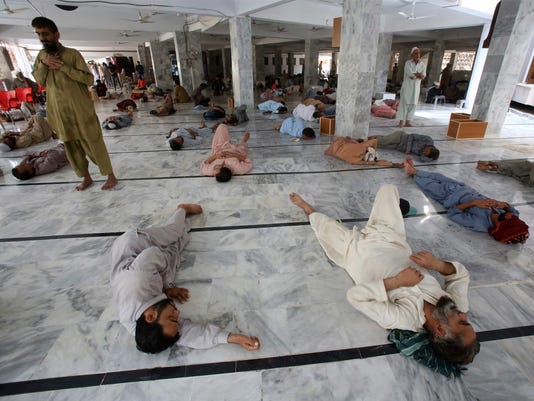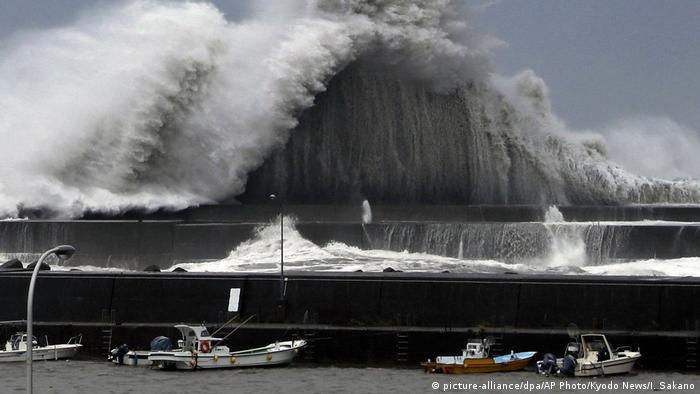
The Public Health Effects of a Warming World are Worse for the Most Vulnerable

- August 7, 2018: Besides the huge Mendocino Complex, there were four other extremely large fires consuming large swaths of the state as well. (courtesy NASA)
Spurred by continued dependence on fossil fuels and industrial economies, climate change and its effects continue to rage around the globe. 2018 has already smashed records in temperatures, floods and typhoons. Wildfires in California this year beat records set last year to become the largest, most expensive and most complex conflagrations in the state’s modern history. This season has been one of the deadliest yet, particularly for wild-land firefighters. The increasing number and longer length of blazes poses an exhaustion risk for firefighters in what was previously a largely seasonal and episodic job and prompted the state’s agency responsible for fire protection, CAL FIRE, to increase the number of prison laborers engaged in wild-land firefighting in a highly criticized decision this past month. Three new fires ignited just this week.
Heat Waves are Becoming More Common and More Deadly
Extreme heat waves with high mortality have struck this year from Quebec, to London, to Karachi, to Japan. These heat waves have toppled temperature records, melted roads, claimed lives, and overwhelmed emergency response and hospital services.

- Patients suffering from heat exhaustion in Karachi, Pakistan in May, 2018. The country’s largest ambulance service said their morgue received 65 bodies over four days, including people who reportedly died after losing consciousness on the streets. (courtesy The Guardian)
In Japan, 57,534 cases of heat exhaustion and heatstroke were reported between April 30 and July 29, including 125 who died from heat-related causes. The number surged as the heat wave took hold following torrential rains which caused flooding and landslides in early July. This year’s heat illness record has already surpassed last year and is expected to outstrip the record set in 2013. The long-running heat wave set new temperature records, including a national high of 41.1 C on July 23. The persistent warming of the earth poses a concealed threat to public health. Gasparini, et al (2017) note that warmer outdoor temperatures closely predict an increase in heat-related morbidity and mortality. Human health is directly affected by heightened exposure to non-optimal outdoor temperatures, but higher temperatures even outside of heat wave events markedly and often insensibly increase all-cause mortality. As noted by University of Miami Bioclimatologist Laurence Kalkstein in a Miami Herald article describing solutions for heat mortality, “Heat is the greatest weather-related killer in the U.S. – greater than tornadoes or hurricanes,” and “results are especially pronounced for maximum and mean temperatures, along with total mortality and those 65 and older.” Researchers at Public Health England (PHE) and the London School of Hygiene and Tropical Medicine predict a 2.1% increase in the number of deaths for every 1C rise. End of century analyses forecast that the average mortality increase varies by region:
In temperate areas such as northern Europe, east Asia, and Australia, the less intense warming and large decrease in cold-related excess would induce a marginally negative net effect, with the net change in 2090–99 compared with 2010–19 ranging from −1.2% in Australia to −0.1% in east Asia under the highest emission scenario… Warmer regions, such as the central and southern parts of America or Europe, and especially southeast Asia, would experience a sharp surge in heat-related impacts and extremely large net increases, with the net change at the end of the century ranging from 3.0% in Central America to 12.7% in southeast Asia under the highest emission scenario.
A 2017 study by Weinberger et al. applying these data sets to metropolitan areas in the United States forecasts that across 10 metropolitan areas, mortality is expected to increase by 10,300 heat-related deaths a year by 2050 and 26,000 heat-related deaths annually by 2090, compared to only about 2,300 in 1997. A “better case scenario” predicts heat-related mortality to increase to approximately 7,700 by 2050 and 10,400 by 2090 from the 1997 baseline. Gregory Wellenius, associate professor of epidemiology in the Brown University School of Public Health notes that “the conversation about climate change is typically focused on the costs of mitigation, but this paper shows the human toll of policy inaction. These results show the cost in terms of human lives due to just this one aspect of climate change: temperature. We have here an opportunity to save lives and improve people’s health.”
Catastrophic Storms Affect Vulnerable Patient Populations More Severely

Massive waves strike a breakwater in the town of Aki, Kochi Prefecture, in western Japan. (Courtesy AP Photo)
Japan was struck by yet another climate disaster last week in the form of Typhoon Jebi, the most powerful Pacific tropical cyclone in a quarter century. Shocking images show massive swells crashing into harbors as the typhoon made each of its three landfalls. Meanwhile, the 2018 Atlantic Hurricane Season is only just unfolding but this year has yielded the highest number of early season subtropical storms since 1974, and Hurricane Florence threatens to be the most powerful storm to ever make a Mid-Atlantic landfall. As we recognize the anniversaries of catastrophic Hurricanes Katrina in 2005, as well as Harvey, Irma and Maria last year, the Atlantic Basin is rife with storms seething towards the Caribbean and US East Coast. The National Hurricane Center recommends interests in these areas hasten disaster planning. But typical disaster response planning often fails to incorporate consideration of marginalized communities and patient populations.

Climate change brings with it an increase in intensity, frequency, and duration of cataclysmic events and subsequent public health emergencies. These disasters include classically recognized collapses in civil service and infectious disease outbreaks. However, beyond the initial havoc wrought by storms and wildfire, disasters also dramatically increase the morbidity and mortality of smoldering crises. Patients who already struggle to manage chronic illness are exposed to sharply heightened risk scenarios in the ensuing days and weeks of a disaster event. Studies of people who inject drugs in New York City, New Orleans, South Florida, Houston and Puerto Rico following climate disasters affecting each of those locations in the past decade found that essential public health services to prevent overdose and infection risk frequently collapse, leading to soaring morbidity and mortality effects. While NYC has a model network of harm reduction service organizations, the effects of Hurricane Sandy in 2015 on services for some of the most vulnerable and at-risk patient populations of people who inject drugs was profound. A 2015 study in the journal Substance Use & Misuse drew on interviews of 300 persons who use drugs about their experience in the week following Sandy’s landfall, finding that:
60% experienced withdrawal; 27% shared drug injection or preparation equipment or injected with people they normally would not inject with; 70% of those in opioid maintenance therapy could not obtain sufficient doses; and 43% of HIV-positive participants missed HIV medication doses. Though relatively brief, a hurricane can alter drug environments and behaviors, and may have lasting impact.
Andrew Golub, a researcher at the National Development and Research Institutes (NDRI) notes that the problems of alcoholism and addiction become more public in a storm. “During a storm, it becomes harder to hide and cope with one’s addiction in private.” In Hurricanes Drive Addiction Issues Into Public Square, Carla Johnson writes that “Drug users took chances during storms, avoiding evacuation to stay near their dealers or sharing needles with strangers putting themselves in danger of HIV and hepatitis. Those in treatment missed doses of medications and went back to street drugs to avoid withdrawal… during Sandy, clinics that lost power measured methadone by candlelight.” Despite buprenorphine treatment recognized by the CDC and SAMHSA as best practice for medication-assisted addiction treatment (MAT), methadone clinics are the only accessible MAT model in many municipalities in the US. While methadone clinics are required to have disaster contingency plans, the model limits patient autonomy and resilience during protracted events, leading to the unacceptable faltering of addiction treatment plans and all ensuing sequelae of unmonitored opioid use.
For areas of the country where resources are already limited, the effects of a storm are ever more dire. In Drug Abuse Linked to Extreme Weather, Marlene Cimons writes that “socioeconomic factors and natural disasters should become part of any national conversation about how to tackle America’s wave of opioid deaths…It is reasonable to expect that damage and destruction cause emotional and mental health problems and lead to drug abuse, both new and existing users.” Cimons draws on the research of Meri Davlasheridze, a professor of Marine Sciences at Texas A&M. Davlasheridze found that drug mortality in New Orleans more than quadrupled from 3.45 per 100,000 people in the years between 1999 and 2004 to 16.1 drug deaths per 100,000 in the immediate aftermath of Katrina. While there are many possible reasons for this increase in drug mortality including changing drug markets, drug composition, and use habits, this trend has been repeated elsewhere: Areas affected by Superstorm Sandy also showed a sharp increase in drug death rates after 2012. “There are many factors that contributed to this rise, and disasters are one of them.” Britni de la Cretaz observed similar circumstances for people struggling with addiction in What Happens to Drug Users During a Natural Disaster, during Harvey’s impact on Houston:
While other people may have been seeking out small amounts of food or water during breaks in the storm, these people were out looking for drug dealers when the rain let up, hoping to score enough to hold them over until the next lull. For people who are physically dependent on a substance, their need to avoid withdrawal symptoms could trump their ability to tend to other crises happening around them.
People who use injection drugs in Puerto Rico saw even more dismal circumstances in the aftermath of Hurricane Maria. As David Ovalle writes in the Miami Herald, public health departments maintained their pre-storm indifference to the high mortality risk faced by opioid users following the storm, leaving public health activists and harm reductionists to continue to provide outreach to these communities.
- Mountain Point outreach counselor Carlos Sanchez carries supplies from a storage area in Cidra, Puerto Rico, Oct. 19, 2017. (courtesy Miami Herald)
For decades, Puerto Rico has battled an epidemic of addiction to injection drugs,particularly heroin, with fentanyl […] emerging in recent years. With a $73 billion debt crisis and years of a spiraling economy, there’s little public appetite to spend money on treatment efforts. Because so many addicts inject drugs, Puerto Rico has one of the highest HIV/AIDs rates in the country, with nearly 40 percent suspected of contracting the virus from injection drug use. In contrast to many U.S. states… Puerto Rico has few options for treatment, with only about a dozen detox centers…few offering drugs such as methadone and buprenorphine to wean users off heroin. For harm reduction programs… operating was a challenge even before the hurricanes. They survive on private donations, not government money. Island authorities do not allow for the distribution of the anti-opioid drug Narcan, which revives users suffering from overdoses… Workers from an organization called El Punto en la Montaña (The Mountain Point), brought packets of clean syringes, mounds of antibacterial wipes and rolls of gauze from a dwindling supply. In the wake of the storm, their goal is to keep opioid users… free from deadly diseases they could get from injecting drugs.
“Excess Mortality” from Storms is a More Accurate Method for Analysis of Disaster Impacts
Other vulnerable communities and patient populations face extreme risk during extreme weather events. Normally indolent chronic diseases account for a major increase in mortality in the post-disaster period. As Arrieta et al. (2009) determined, “the proportion of Katrina affected persons with 1 or more chronic illness diagnoses was estimated between 41% and 74% whereas an extreme increase in mental illness was also observed.” A 2015 study out of Rutgers Robert Wood Johnson Medical School uncovered that in the two weeks following Hurricane Sandy, in the eight counties determined to be high-impact areas, there was a twenty-two percent increase in heart attacks as compared with the same time period in the previous five years. In areas which saw less impact from the storm, the increase was less than one percent. Thirty-day mortality from heart attacks also increased by thirty-one percent in the high-impact area. Similarly, patients with diabetes face dramatically increased risk in disaster events. In their paper “Diabetes, Disasters and Decisions,” Allweiss and Albright (2011) write that following disasters:
Glycemic control among people with diabetes deteriorates. People with diabetes are at increased risk for morbidity and mortality caused by complications, such as diabetic ketoacidosis and foot infections, and ED visits for people with diabetes increase Certain groups, such as the elderly, people of low socioeconomic status, people without health insurance, and many minorities, become even more vulnerable during disasters and experience increased morbidity and mortality in increase in admissions of people with newly-diagnosed Type 1 diabetes has also been reported post-disaster.
Multiple analyses of the death toll in Puerto Rico following Maria, including most extensively by the Milken Institute School of Public Health at George Washington University, led to an official revision of the death toll from 67 to 2975, to account for excess mortality:
The impacts of Hurricane Maria, September 2017. The disaster was felt even more heavily by the most vulnerable patient populations. (courtesy NY Daily News)
Every social stratum and age group was affected by excess mortality. However, the impact differed by age and socioeconomic status. The risk of death was 45% higher and persistent until the end of the study period for populations living in low socioeconomic development municipalities, and older males (65+) experienced continuous elevated risk of death through February [2018]. Overall, we estimate that 40% of municipalities experienced significantly higher mortality in the study period than in the comparable period of the previous two years. We conclude that excess mortality is a good indicator for impact monitoring during and in the aftermath of a disaster.
As climate change continues unabated, we will continue to see the public health effects of a hotter planet. These impacts are felt by everyone, but not equally: structural inequality and economic marginalization expose vulnerable communities, particularly in the global south, to the greatest risks of harm. Public health officials and activists must incorporate risk mitigation strategies responsive to the needs of the most vulnerable and stigmatized groups to avert the disastrous rise in mortality for these populations.
- For an example of a public health system incorporating harm reduction methodology into disaster planning responsive to the unique needs of patients in chronic opioid maintenance therapy, see this short documentary by Prevention Point Pittsburgh: Without a Net
- For a best practices guide from the CDC on caring for elder adults and special needs populations during a disaster event, please see Identifying Vulnerable Older Adults and Legal Options for Increasing Their Protection During All-Hazards Emergencies
- Similarly, Insuring Continuity of Care for Chronic Disease Patients After a Disaster: Key Preparedness Elements by Arrieta et al. (2009) contains numerous evidence-based practices for chronic disease disaster planning.
- Global Cool Cities is an organization working to decrease urban thermal heat islands and the attendant increase in mortality. See their work here.
Report by Kasha Bornstein, MSPharm














